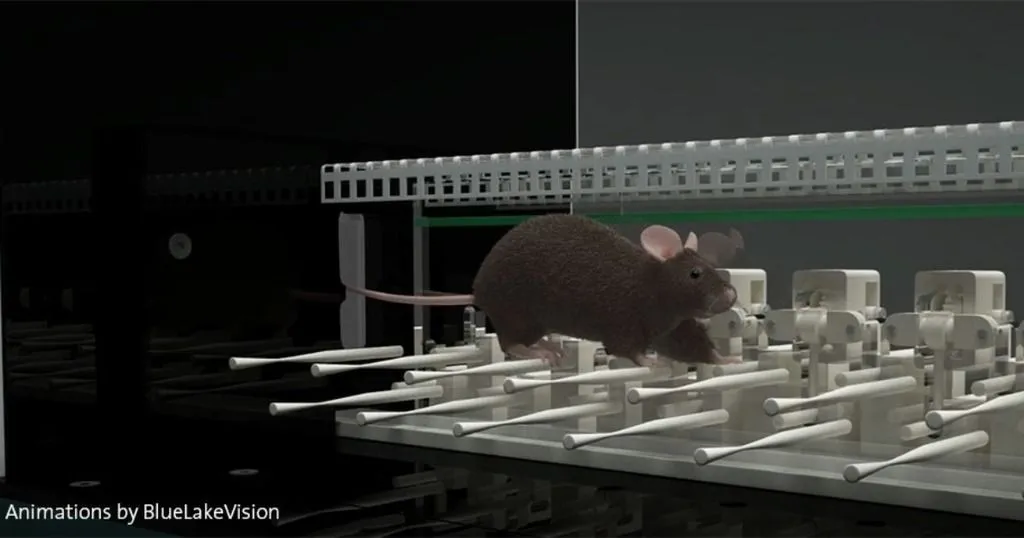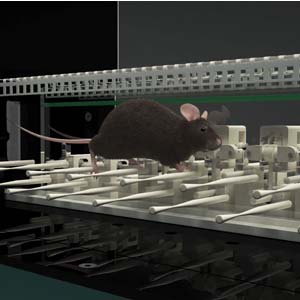How to study ataxia
Ataxia is a common problem in Parkinson’s disease (PD), and many early onset Alzheimer’s disease patients (AD) also deal with it. Now there is a non-invasive test for mouse models.
Posted by
Published on
Fri 03 Jul. 2015
Topics
| Alzheimer's Disease | Cerebellum | ErasmusLadder | Gait | Locomotion | Motor Learning | Parkinson's Disease |

Gait and motor performance are studied extensively in neuroscience research, which is not surprising when you come to think of it, because it is affected in many neurological diseases. Ataxia is a common problem in Parkinson’s disease (PD), and many early onset Alzheimer’s disease patients (AD) also deal with it. Motor skills are also affected in patients with autism spectrum disorders (ASD) and attention deficit hyperactivity disorder (ADHD).
To study the underlying mechanisms and possible treatments of the motor control issues associated with these disorders, several, mostly invasive, tests have been developed to investigate mouse models. The cerebellum plays a crucial role in motor coordination, precision, and accurate timing and thus is the focus of many studies in this area.
A couple of years ago, the Erasmus MC (Rotterdam, The Netherlands) started the development of the ErasmusLadder, a completely new testing paradigm specially designed to assess motor learning and performance. The ErasmusLadder is now commercially available, and this post will list three examples of research with this tool.
The essential role of granule cells in motor learning
Cerebellar granule cells form a large and important part of the vertebrate central nervous system. To uncover the role of these neurons in motor functioning, Galliano et al. minimized the output of these cells in a mice model and compared their locomotor performance to a wild type group. The ErasmusLadder test was one of the tests used to investigate both motor performance and motor learning skills. Interestingly, they found that overall motor performance was intact, indicating that only a few functioning granule cells are necessary for this. But, when it came to testing actual motor learning and memory, the significant differences between the treatment and the wild type group made it clear that this requires a higher number of functional granule cells.
Galliano, E.; Gao, Z.; Schonewille, M.; Todorov, B.; Simons, E.; Pop, A.S.; D’Angelo, E.; Maagenberg, A.M.J.M.; Hoebeek, F.E.; De Zeeuw, C. (2013). Silencing the Majority of Cerebellar Granule Cells Uncovers Their Essential Role in Motor Learning and Consolidation. Cell Reports, 3, 1239-1251.
Different cells have different roles in motor performance
Maria Fernanda Vinueza Veloz and her colleagues also investigated specific neurons. In their study Purkinje cells, interneurons, and granule cells where the focus. Several knock-out strains were tested on the ErasmusLadder to unravel the role of each of the cell types. Motor performance was decreased in mice with decreased Purkinje cell output, as was evident from their ataxia-like phenotype. Other knock-out strains did not seem impaired in their motor performance, however, motor learning was difficult for all the treated mice. In addition, none of the mice showed lack of motivation as was evident from their willingness to leave the goal box. (For more about this research see this blog post.)
Vinueza Veloz, M.F.; Zhou, K.; Bosman, L.W.J.; Potters, J.-W.; Negrello, M.; Seepers, R.M.; Strydis, C.; Koekkoek, S.K.E.; De Zeeuw, C.I. (2014). Cerebellar control of gait and interlimb coordination. Brain Structure and Function, doi: 10.1007/s00429-014-0870-1.
Do plaques in the cerebellum cause ataxia?
Diego Sepulveda-Falla and his colleagues were part of a study that was described in the media as groundbreaking research last year. They worked together with a cohort of 25 families from the Antioquia area in Colombia with a high prevalence of early onset familial Alzheimer’s (FAD) that was discovered to be caused by a mutation in the presenile1 (PS1) gene. Here, patients were symptomatic even before beta amyloid plaques were likely to occur in the brain, which is striking, since these protein build-ups in the brain were main suspects in the cause of the symptoms thus far. The same effect was found in a murine model of PS1 FAD – tests with the ErasmusLadder revealed motor performance and motor learning problems even before plaques were found in the cerebellum.
While previously it was thought that the gene mutation causes plaques, which in turn causes the symptoms, this study suggests that the PS1 mutation causes ataxia in these patients through a different mechanism in the cerebellum. This is especially interesting in light of the current clinical study family members have entered, because here a drug is tested that is specifically targeted at preventing the formation of plaques.
The researchers are now eagerly awaiting the data to see if the ataxia also disappears (For more about this research see this blog post.)
Sepulveda-Falla, D.; Barrera-Ocampo, A.; Hagel, C.; Korwitz, A.; Vinueza-Veloz, M.F.; Zhou, K.; Schonewille, M.; Zhou, H.; Velazquez-Perez, L.; Rodriguez-Labrada, R.; Villegas, A.; Ferrer, I.; Lopera, F.; Langer, T.; De Zeeuw, C.I.; Glatzel, M. (2014). Familial Alzheimer's disease-associated presenilin-1 alter cerebellar activity and calcium homeostasis. Journal of Clinical Investigation, 124(4), 1552-1267.
Related Posts

Can caffeine prevent Alzheimer's?

Agricultural pesticides and Parkinson's Disease: current screening procedures

